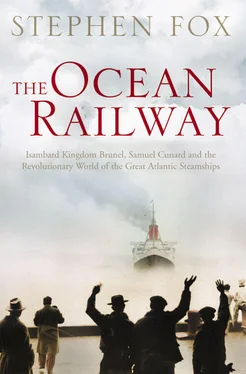The machine was working, though, with the strong and steady rhythm of a heartbeat, practically without stopping, all the way across the ocean. A new era was finally at hand. ‘ How this glorioussteamer wallops, and gallops, and flounders along!’ wrote a passenger on the Great Western. ‘She goes it like mad. Its motion is unlike that of any living thing I know; puffing like a porpoise, breasting the waves like a sea-horse, and at times skimming the surface like a bird. It possesses the joint powers of the tenants of the air, land, and water, and is superior to them all.’ As the days passed, the ship clicked off daily runs never before achieved on a westward crossing. A new speed record seemed easily in reach.
The Sirius, nearly out of fuel, reached New York on 23 April. The Great Western came in only twelve hours later after a voyage of fifteen and a half days, the fastest crossing ever from England to America. Of her initial 660 tons of coal, she had 203 tons left in her bunkers – a reassuring margin of safety, for prospective customers, in the most doubted, uncertain aspect of transatlantic steam. The Great Western took sixty-six passengers on her trip back to Bristol. After losing almost £4000 on her first passage out and home, she made four more round-trips that year, turning small profits and lowering her own records in both directions. Already, at this early point, ocean travellers had begun to accept the modernist bargain of steam dangers and discomforts in exchange for consistent, unprecedented speed. In September the Great Western carried 131 passengers to New Yorkand had to refuse 30 more for lack of space. This passage took sixteen days, nine hours – almost one day slower than her maiden, but still two weeks faster than a crack sailing packet.
The Great Western puffed back and forth across the ocean while the British Queen inched along towards completion. It was a surprising reversal of expected form, Bristol over London, the fading western port over the burgeoning urban colossus; so London, seeking an explanation, blamed Glasgow. During the spring and summer of 1839, partisans of the Thames and the Clyde engaged in a ferocious public debate about the practical wisdom of sending the British Queen north for her machinery. ‘ Here we havea magnificent vessel dragged from the Thames to Glasgow, at great risk and expense, in search of engines,’ wrote a man from Cheapside in London. ‘All the world, except the sapient gentlemen connected with the “British Queen” are perfectly aware that London-made steam-engines (like most London-made goods) are decidedly the best… Our good friends, the Scotch, proverbially know how to pass off certain inferior birds “as swans”.’ In rebuttal, Robert Napier’s friends pointed out that he had been obliged to replace and reinforce much of the carpentry work installed by the British Queen’s southern shipwrights. Napier also had to lower the keelsons (heavy bracing timbers that ran parallel to the keel) by about six inches just to fit his taller machinery into the engine room. ‘The people in the North,’ said one rebutter, ‘…consider the London-built ships very light and flimsy; in proof of which, amongst many other improvements made in the British Queen at Port Glasgow, it was deemed absolutely necessary to strengthen her with several additional iron knees. It is notorious that steam and other ships can be built and fitted out, decorated, and finished, as expeditiously on the Clyde as on any other river in the world.’
These arguments drew on ancient, bitter rivalries between Glasgow and London, Scotland and England, North and South. British political and commercial power was centred in London, to the continuous irritation of the provinces. But Scotland could still claim a better educational system and an older, more eminent engineering tradition than the Thames – and the famous Scottish thrift. Clydeside builders paid lower wages and enjoyed closer, cheaper access to coal and iron than Londoners, which meant they could build steam engines less expensively. That introduced another element to the public debates: ‘the avarice or parsimoniousness of steam-boat companies,’ as one Clyde defender put it, ‘who, finding that their orders can generally be more cheaply executed by Scotch engineers than London ones, run to them, and instead of being liberal in their dealings, screw them down to contracts, not consistent either with good materials or workmanship.’ Such sharp practices, so this explanation ran, left Clyde engineers the unhappy choice of losing highstandard business or producing shoddy work at cut rates that harmed their reputations as engine builders.
The contest between the Great Western and the British Queen, overtly a race to dominate Atlantic steam, became an acrid showdown between the two main centres of British shipbuilding and marine engineering. With a lucrative market for transatlantic steamers just opening up, the outcome could have a decisive impact on the steam futures of London and Glasgow. ‘If our Scotch friends would puff their work less, and perform more, it would be more creditable to them,’ a shipping official in London suggested. After all, shipboard explosions of Glasgow boilers had caused far more deaths than accidents on London vessels; but perhaps – came the reply – that was just because the Clyde had produced so many more steamships than the Thames. ‘Let any one travel by the Thames river steamers,’ wrote a Scots enthusiast, ‘and then go and take a trip by the fleet, strong, and beautifully-built Clyde boats, and then say without prejudice which he prefers… No engineers in the world are more ably qualified for the just, cautious, and accurate execution or manufacture of marine steam-engines, than are the Scotch.’
Provincial rhetorics aside, the real-world proof of the matter lay in the ships themselves. The British Queen did replace her rival as the biggest, highest-powered steamship in the world: 275 feet long, 1863 tons, and an engine jacked up beyond its contracted size to 500 horsepower. Robert Napier sent the ship down to the Thames for final fittings before her maiden voyage; his cousin David Napier, who had moved to London, gave her a suspicious inspection. ‘ They unfortunately letone of the boilers get dry while coming round, either carelessly or willingly,’ David informed Robert, hinting at possible Thamesian sabotage, ‘which has given the Cockneys another handle against Scotch engineers.’ The British Queen at last left for New York on 12 July 1839 (fifteen months after the Great Western’s maiden). Junius Smith and Macgregor Laird went along as her most interested passengers. Also aboard, and quite interested himself, was Samuel Cunard of Halifax, returning home from business in England, and by this time quite intent on developing his own steamers across the Atlantic.
Laird’s unpublished diary of the voyage, recently discovered and donated to the Merseyside Maritime Museum in Liverpool, is a doleful litany of worries and discomforts. As the ship’s main designer, he felt the burden of responsibility for her performance. At midsummer the weather should have been as favourable as the westward run ever allowed. Instead the British Queen fought unusually strong opposing winds and currents, and Laird – famous for an earlier African river expedition, but normally an armchair sailor – spent most of the trip miserably seasick. For days he could eat nothing but brown biscuit; he envied the nine or ten women who lay supine in the ladies’ cabin, quaffing six expensive bottles of champagne a day to relieve their queasiness. Hopefully overestimating the ship’s speed, a proud father ever blind to his offspring’s limitations, Laird kept losing bets on the daily run. ‘Summer passage indeed!’ he exclaimed. ‘It’s hard, very hard upon me – there she goes, pitch and toss! Talk of her being large! She is a plaything on the ocean.’
Читать дальше












